We won't really know who "won" the Orlando Brown Jr. trade for a few years, once we see how all the players involved turn out and the impact they make on their new teams.
But with the 2021 draft in the rear-view mirror and the Ravens' free-agent replacement signed, we have a better idea of what each side netted in the trade.
Since this was such a huge move (it's not often that multi-year Pro Bowlers in their 20s get traded) that will have ramifications for years to come, it's worth taking a deeper dive.
Chiefs:
- OT Orlando Brown Jr.
- LB Nick Bolton (pick No. 58)
- 2022 sixth-round pick
Ravens:
- OLB Odafe Oweh (pick No. 31)
- OG Ben Cleveland (pick No. 59)
- CB Shaun Wade (pick No. 160, from Arizona)
- 2022 fourth-round pick (from Arizona, via trade of 2021 fourth-round pick No. 136)
- 2022 fifth-round pick
Three days after the draft, the Ravens filled the hole left by Brown's departure by signing veteran offensive tackle Alejandro Villanueva.
That was not part of the deal, but from the Ravens' perspective, it was certainly part of the calculation. Remember, they brought in Villanueva for a visit before they traded Brown. So, for the sake of this exercise, I think it's only fair to factor Villanueva into this exchange.
From a financial standpoint, Brown will cost approximately $3.4 million against the Chiefs' salary cap this season. Then he'll be a free agent. Assuming he stays on his current trajectory, Brown will cash in with a massive deal, probably north of $15 million per year. According to reports, Villanueva's two-year deal with the Ravens is worth $14 million total.
So, is Villanueva half the player Brown is? Pro Football Focus graded Brown at 76.5 overall last season. Villanueva was 74.6. Brown allowed three sacks in 514 pass blocking snaps while Villanueva yielded three in 714 pass blocking snaps. According to ESPN's run block win rate, Brown came in at No. 21. Villanueva ranked No. 18 for the second straight year.
All grades aside, it's fair to say that the 32-year-old Villanueva isn't at the same level as the 25-year-old Brown, and their long-term prospectus is headed in opposite directions. There's a reason or two why Villanueva sat unsigned on the free-agent market for nearly two months whereas Brown fetched a first-round pick.
But is their value that far apart, particularly when cost is factored in? Off the field, I really liked Brown. Everybody did. But after Villanueva's introductory press conference, I've got to say, he is an impressive man, too.
By trading Brown, the Ravens got a rookie pass rusher with an extremely high ceiling in Oweh, which filled a desperate need. If Oweh reaches his potential, he alone could make the trade worthwhile.
Baltimore also got Cleveland, who like Brown is a massive, road-grading blocker. Cleveland may be good enough to immediately start at left guard. The Ravens lost trench physicality and nastiness with Brown's departure, but Cleveland brings a whole lot of that himself, just a few feet over.
The Ravens got another high upside prospect in Wade, who would have been picked in the first two days had he opted out last season. Plus, what shouldn't be forgotten is the extra fourth-round pick next year that Baltimore got by packaging pick No. 136 from the Chiefs in the trade with the Cardinals.
Now, what would the Ravens have looked like if they didn't trade Brown?
They would have had one more year of Brown, who wouldn't have been happy to be back at right tackle but would have been a good teammate and still played at a very high level. They could have tagged him, but that would have been extremely costly and probably further damaged the relationship. Much more likely is he would have left in free agency next offseason and the Ravens would have received a compensatory pick (possibly in the third round, but not guaranteed) in the 2023 draft.
With the second-round pick the Ravens traded to the Chiefs (No. 58), the Ravens could have selected wide receiver Terrace Marshall Jr., who went No. 59 to the Carolina Panthers after being widely projected to Baltimore in the first round. Well, except that Baltimore had already picked their preferred wideout, Rashod Bateman, at No. 27.
The Ravens could have taken defensive end Carlos Basham Jr. (No. 61, Buffalo) because they wouldn't have had Oweh. Or Baltimore could have drafted centers Josh Myers (No. 62, Green Bay) or Creed Humphrey (No. 63, Kansas City). Or they could have taken an offensive tackle to eventually replace Brown, such as Jalen Mayfield (No. 68, Atlanta) or Brady Christensen (No. 70, Carolina).
But at the end of the day, the Ravens are thrilled with the draft picks they made and the pundits’ report cards reflected similar feelings.
Let's be clear. The Ravens would have liked to keep Brown. If he hadn't requested a trade, I imagine none of this would have happened. Heck, if there was a magical financial way to pull it off, the Ravens would have loved to re-sign Brown to a contract extension themselves. He was a Raven, through and through.
But the Ravens will soon be in a different reality once Lamar Jackson gets paid, one that requires more tough decisions. In this instance, Brown accelerated the process. Once the Ravens decided they would work to honor Brown's request, General Manager Eric DeCosta was tasked with making the best of the situation. And by my calculation, he did pretty darn well.



















